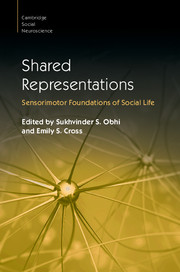Book contents
- Shared Representations
- Cambridge Social Neuroscience
- Shared Representations
- Copyright page
- Contents
- Figures
- Tables
- Boxes
- Contributors
- Preface
- Part I Foundations
- Part II Imitation and Mimicry
- Part III Thinking, Perceiving and Acting with Others
- Part IV Understanding Others
- Part V Learning and Development
- 21 Shared Interoceptive Representations
- 22 Mirror Neuron Formation via Associative Learning
- 23 Disorders of Shared Representations
- 24 Learning by Diffusion
- 25 Observational Motor Learning
- 26 The Impact of Action Expertise on Shared Representations
- Part VI Shared Representations in Applied Contexts
- Index
- Plate Section (PDF Only)
- References
24 - Learning by Diffusion
Using Diffusion Experiments and Social Network Analysis to Understand the Dynamics of Cultural Evolution
from Part V - Learning and Development
Published online by Cambridge University Press: 27 October 2016
- Shared Representations
- Cambridge Social Neuroscience
- Shared Representations
- Copyright page
- Contents
- Figures
- Tables
- Boxes
- Contributors
- Preface
- Part I Foundations
- Part II Imitation and Mimicry
- Part III Thinking, Perceiving and Acting with Others
- Part IV Understanding Others
- Part V Learning and Development
- 21 Shared Interoceptive Representations
- 22 Mirror Neuron Formation via Associative Learning
- 23 Disorders of Shared Representations
- 24 Learning by Diffusion
- 25 Observational Motor Learning
- 26 The Impact of Action Expertise on Shared Representations
- Part VI Shared Representations in Applied Contexts
- Index
- Plate Section (PDF Only)
- References
Summary
Culture arises from the interaction of many individuals sharing knowledge and collaborating over time, and, because of this, culture must be studied using different methods to those that are commonly employed in many areas of psychology. The majority of our understanding of the social learning underpinning culture is generalised from ‘dyadic’ experiments, in which a single participant observes a single model, and as a result leaves questions about the relationship between the individual- and group-level unaddressed. Such questions include how different forms of cultural information spread across the population and how individuals work together to produce cultural products. Diffusion experiments present a method for such dynamics to be examined. This chapter reviews the varieties of diffusion methods available and the strengths and weaknesses each type of diffusion design provides in answering questions about cultural evolution. It also reviews recent innovations in studying the spread of culture via social relations using social network analyses. We argue that social network analyses could be especially useful for examining a dynamic which has hitherto not been widely considered in studying cultural evolution; that is, the feedback relationship between social structure (relations) and social learning, with copying behaviour fulfilling both a role of information exchange and a role of affiliation.
- Type
- Chapter
- Information
- Shared RepresentationsSensorimotor Foundations of Social Life, pp. 503 - 524Publisher: Cambridge University PressPrint publication year: 2016
References
- 3
- Cited by

